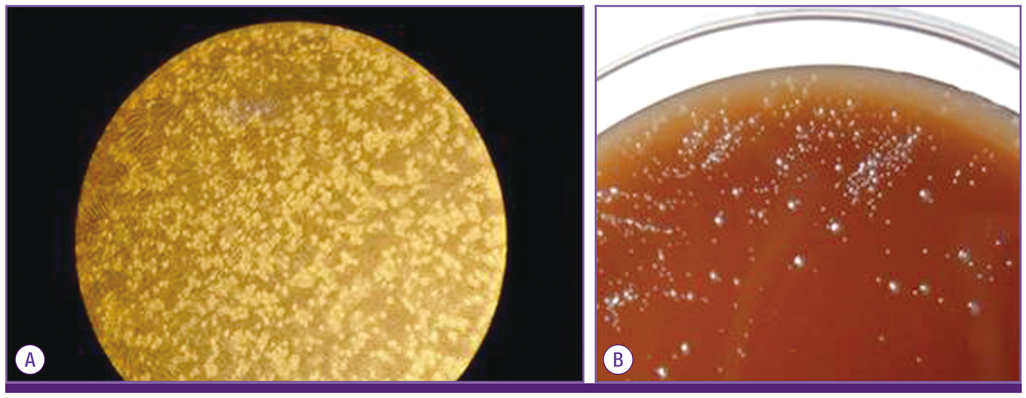Infect Chemother.
2013 Dec;45(4):446-450. 10.3947/ic.2013.45.4.446.
First Case of Bartonella henselae Bacteremia in Korea
- Affiliations
-
- 1Department of Internal Medicine, Inha University School of Medicine, Incheon, Korea. ljinsoo@inha.ac.kr
- 2Translation Research Center, Inha University School of Medicine, Incheon, Korea.
- 3Department of Microbiology, Inha University School of Medicine, Incheon, Korea.
- KMID: 2170450
- DOI: http://doi.org/10.3947/ic.2013.45.4.446
Abstract
- Bartonella henselae causes cat-scratch disease, bacteremia, and various focal infections. Despite the worldwide occurrence of B. henselae infections, reports in humans are rare in Korea. The clinical manifestation of all 5 previously reported cases was lymphadenopathy. Herein, we report a case of bacteremia in a woman who presented with prolonged fever. B. henselae was isolated from a blood specimen by cell culture. Conventional polymerase chain reaction amplification and sequencing of the 16S-23S rRNA intergenic space region confirmed the isolate to be B. henselae. The patient had no underlying immunocompromising conditions and no recent exposure to animals. She was successfully managed with a combination of doxycycline and hydroxychloroquine.
MeSH Terms
Figure
Reference
-
1. Chae MB, Lee JY, Kwak YG, Park SH, Lim HJ, Park SW, Chung MH, Kim MK, Kang JS. Prevalence of antibodies to Bartonella henselae and Bartonella quintana in Korean patients with lymphadenopathy. Korean J Infect Dis. 2002; 34:305–310.2. Lee JY, Kang JS, Kim MK, Hwang TS, Kwak YG, Chae MB, Jang CS, Kim IK, Seo DB, Chung MH. The prevalence of Bartonella henselae infection in Korean feral cats. Korean J Infect Dis. 2001; 33:319–324.3. Kim CM, Kim JY, Yi YH, Lee MJ, Cho MR, Shah DH, Klein TA, Kim HC, Song JW, Chong ST, O'Guinn ML, Lee JS, Lee IY, Park JH, Chae JS. Detection of Bartonella species from ticks, mites and small mammals in Korea. J Vet Sci. 2005; 6:327–334.
Article4. Kim YS, Seo KW, Lee JH, Choi EW, Lee HW, Hwang CY, Shin NS, Youn HJ, Youn HY. Prevalence of Bartonella henselae and Bartonella clarridgeiae in cats and dogs in Korea. J Vet Sci. 2009; 10:85–87.
Article5. Chae JS, Yu do H, Shringi S, Klein TA, Kim HC, Chong ST, Lee IY, Foley J. Microbial pathogens in ticks, rodents and a shrew in northern Gyeonggi-do near the DMZ, Korea. J Vet Sci. 2008; 9:285–293.
Article6. Han TH, Chung JY, Seong HK, Kim SW. Molecular detection of Bartonella henselae DNA from fleas obtained from dogs, Korea. Korean J Pediatr. 2006; 49:983–986.
Article7. Chung JY, Koo JW, Kim SW, Yoo YS, Han TH, Lim SJ. A case of cat scratch disease confirmed by polymerase chain reaction for Bartonella henselae DNA. Korean J Pediatr. 2005; 48:789–792.8. Kim MH, Kim BN, Han TH. Cat-scratch disease: a case report and literature review of human and animal studies performed in Korea. Infect Chemother. 2012; 44:299–302.
Article9. Lim MH, Chung DR, Kim WS, Park KS, Ki CS, Lee NY, Kim SM. First case of Bartonella quintana endocarditis in Korea. J Korean Med Sci. 2012; 27:1433–1435.
Article10. Welch DF, Pickett DA, Slater LN, Steigerwalt AG, Brenner DJ. Rochalimaea henselae sp. nov., a cause of septicemia, bacillary angiomatosis, and parenchymal bacillary peliosis. J Clin Microbiol. 1992; 30:275–280.
Article11. Maggi RG, Duncan AW, Breitschwerdt EB. Novel chemically modified liquid medium that will support the growth of seven Bartonella species. J Clin Microbiol. 2005; 43:2651–2655.
Article12. Maggi RG, Mascarelli PE, Pultorak EL, Hegarty BC, Bradley JM, Mozayeni BR, Breitschwerdt EB. Bartonella spp. bacteremia in high-risk immunocompetent patients. Diagn Microbiol Infect Dis. 2011; 71:430–437.13. Houpikian P, Raoult D. 16S/23S rRNA intergenic spacer regions for phylogenetic analysis, identification, and subtyping of Bartonella species. J Clin Microbiol. 2001; 39:2768–2778.
Article14. Kil SH, Kang JS. Production of the monoclonal antibodies against Bartonella henselae isolated from a Korean patient. J Bacteriol Virol. 2012; 42:41–47.
Article15. Park SD, Chung MH, Lee HM, Kim MK, Kang JS. A case of scrub typhus in summer presenting as atypical pneumonia. Infect Chemother. 2008; 40:241–245.
Article16. La Scola B, Raoult D. Serological cross-reactions between Bartonella quintana, Bartonella henselae, and Coxiella burnetii. J Clin Microbiol. 1996; 34:2270–2274.
Article17. Jacobs RF, Schutze GE. Bartonella henselae as a cause of prolonged fever and fever of unknown origin in children. Clin Infect Dis. 1998; 26:80–84.
Article18. Rolain JM, Brouqui P, Koehler JE, Maguina C, Dolan MJ, Raoult D. Recommendations for treatment of human infections caused by Bartonella species. Antimicrob Agents Chemother. 2004; 48:1921–1933.
Article19. Rolain JM, Colson P, Raoult D. Recycling of chloroquine and its hydroxyl analogue to face bacterial, fungal and viral infections in the 21st century. Int J Antimicrob Agents. 2007; 30:297–308.
Article20. Minnick MF, Battisti JM. Pestilence, persistence and pathogenicity: infection strategies of Bartonella. Future Microbiol. 2009; 4:743–758.
Article
- Full Text Links
- Actions
-
Cited
- CITED
-
- Close
- Share
- Similar articles
-
- Production of the Monoclonal Antibodies against Bartonella henselae Isolated from a Korean Patient
- Molecular detection of Bartonella henselae DNA from fleas obtained from dogs, Korea
- A Case of Cat Scratch Disease Confirmed by Polymerase Chain Reaction for Bartonella henselae DNA
- The seroprevalence of Bartonella henselae in healthy adults in Korea
- Infections by pathogens with different transmission modes in feral cats from urban and rural areas of Korea


